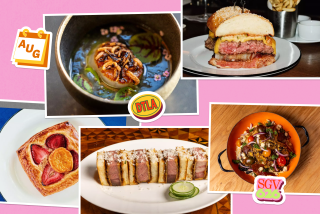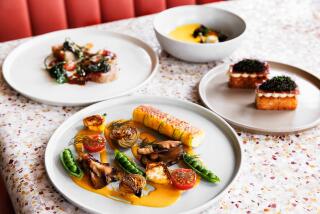A Few Kicks Remain on Road From the Past
- Share via
You road I enter upon and look around, I believe you are not all that is here, I believe that much unseen is also here.
--Walt Whitman, “Song of the Open Road”
Americans always have had a love affair with the open road. It symbolizes freedom and our cherished ability to move on. It offers the promise of transformation of the self--during the journey and upon reaching the destination.
No road in America has spawned more dreams than Route 66. But this road has inspired more than dreams. There have been books, road guides, magazine articles, songs, stories, a major novel, even a hit television series. The 2,200-mile asphalt ribbon once stretched from Chicago to Los Angeles and set free the imagination of dreamers all over the nation. It opened up the modern way west to California.
‘Path of a People in Flight’
In 1926, the road was officially designated Highway 66. Soon afterward, folk singers Woody Guthrie and Pete Seeger wrote “66 Highway Blues,” a paean to the sad, transient life of men unable to find work during the Depression. John Steinbeck immortalized the road in his 1939 Pulitzer Prize-winning masterpiece “The Grapes of Wrath”: “Highway 66 is the main migrant road . . . the path of a people in flight . . . the mother road.”
Dust Bowl migrants traveled the road in desperation, leaving behind a way of life that had dried up and blown away. But they weren’t the only travelers searching for rebirth at the end of the road. Sons and daughters continued the westward movement of their immigrant parents; wanderers, drifters and a new wave of family vacationers all hit the two-lane highway west.
While traveling Route 66 in 1946, songwriter Bobby Troup penned a catchy song that became a memorable musical travelogue through the West:
Now you go through St. Looey,
Joplin, Missouri. And Oklahoma City is mighty pretty;
You’ll see Amarillo; Gallup, New
Mexico;
Flagstaff, Arizona; don’t forget
Winona;
Kingman, Barstow, San Bernardino.
Won’t you get hip to this timely trip;
When you make that California trip,
Get your kicks on Route 66!
By the time the hit television show “Route 66” began its four-year run in 1960, the road virtually had become a cultural icon. Tod and Buz freely traveled from town to town in their shiny red Corvette. They met women, worked at odd jobs along the road and, always, they moved on.
They lived a fantasy life that simply added to the myth of the open road. Tom Snyder, president of the Route 66 Assn., says: “There’s something about the road that promotes experience, some kind of self-discovery as well as discovery of the land and people. Route 66 is all about looking for a place you have never seen, but you know is there.”
As Americans took to the highway, a road culture of sorts sprang up to cater to their needs. Towns appeared in unlikely places, small settlements consisting mostly of curio shops, mom-and-pop diners, service stations, motels and motor courts. Weary travelers could get a hot meal, friendly conversation, some rest and auto repairs. With the construction of the interstate highway system that bypassed or absorbed most of Route 66, many of these small towns simply went out of business. Others continue--smaller, less frequently visited, surely less prosperous than before.
But the historic route--and its distinctive period architecture--has not vanished completely. Route 66 remains intact in a few places in Southern California. It’s just a little harder to find.
Purists insist that the road is properly traveled only from east to west. Travelers who once drove west on Route 66, with dreams of discovering a new life in California, now travel Route 66 east to discover a past that lives in our memory, imagination and, in places, on the road itself.
Santa Monica Boulevard and Ocean Avenue
The journey begins at the foot of Santa Monica Boulevard on the bluffs overlooking the Pacific Ocean. The marker, placed there in 1952 when the road was renamed the Will Rogers Highway, states that Route 66 was “the first road (Rogers) traveled in a career that led him straight to the hearts of his countrymen.”
Chances are, Rogers would hardly recognize the spot today. The stately Georgian Hotel and Bellevue Restaurant remain, but there is also a neon-adorned yogurt stand across the street. Never mind. Head across the street to the American Diner (1401 Ocean Ave.) for a meal before hitting the road.
Try not to notice the herbal teas and plastic-wrapped muffins. Focus instead on the ‘50s-style memorabilia, the shiny red vinyl booths and the countertop jukebox. Manager Billie Burner, informed that the diner sits at the terminus of the historic highway, promised to add “Route 66” to the jukebox selections. Until she does, select a nostalgic number by Sam Cooke, Judy Garland or Frank Sinatra, and let the music transport you to a different time.
Order a cup of coffee too good to be served in a typical diner. Then spread out your maps, and get ready for a trip into America’s past.
Santa Monica Boulevard to U.S. 101
The black-and-white Route 66 signs were replaced in 1964 by green-and-white State Route 2 signs along this stretch. Santa Monica Boulevard is a pretty hip street, but vestiges of yesterday remain. Pass Henshey’s department store and foreign-car dealerships (unthought-of a few decades ago), a trailer court for sale and a cappuccino parlor. Notice Barney’s Beanery (8447 Santa Monica Blvd.), Dukes (8585 Santa Monica Blvd.) and the Mormon Temple, which were on the early route, and Century City, which was not.
Original Route 66 has been absorbed by the maze of interstates leading downtown. Hop on the Hollywood Freeway and continue east to the Pasadena Freeway; exit the Pasadena Freeway at Figueroa Street (exit No. 26). Notice Sycamore Park on your right, and the Southwest Museum towering above on the left. Continue on Figueroa to Colorado Boulevard and turn right.
Colorado Boulevard to Foothill Boulevard
Cross the beautiful arched 1912 bridge over the Arroyo Seco into Pasadena. At the corner of Fair Oaks Avenue, note the Union Garage, built in 1907. Stop a while to walk around in lovely Old Pasadena; with its historic buildings, this is a good place to set the tone for the rest of your journey. Continue on Colorado, turn left on Santa Anita Avenue and right on Foothill Boulevard.
Foothill Boulevard to Interstate 15
This 50-mile stretch is one of the longest and most interesting remaining sections of the original Route 66. This is the land portrayed on classic California post cards--citrus groves in the foreground, snowcapped peaks in back. The foothill towns along this route were once major citrus-packing centers that appealed to the folks back East.
Although the citrus business here has given way to residential housing, office parks and light industry, there are several historically interesting sights along this section of Route 66.
The handsomely landscaped suburb of Arcadia gives way to the city of Monrovia. Stop at the corner of Foothill and Magnolia Avenue to see the Aztec Hotel (311 W. Foothill Blvd.), built in 1926. This structure, imitative of Mayan architecture, was typical of the tourist-enticing structures that were part of the fun of traveling America’s Main Street.
Turn south on Mountain Avenue and left on Huntington Drive to stay on the old road toward Duarte. The Boulevard Cafe (1235 Huntington Drive) is a nostalgic place to stop for lunch. It offers service in the open-air, screened-in porch or at the counter. Order up a chili size or a burger with everything and remember how good quickly served food tasted before fast food came along. Notice the vintage Coca-Cola cooler, the coffeepot kept hot on the grill.
From this point eastward, more of the original features remain, but probably not for long. Interspersed with motor courts evoking an earlier era--the Filly Motel, Rancho Inn and others--are signs announcing “27,000-square-foot shopping center, will build to suit.” Continue through an area of light industry and office parks.
When the route crosses the San Gabriel River, it becomes Foothill Boulevard again. In Azusa, stop to examine the corrugated steel building topped with the Dri-Powr sign, featuring an exotic genie announcing “Improves Engine Performance--Since 1935.”
In Glendora, detour off the original route to see the Glendora Bougainvillea, one of the only-in-California sights that have appealed to visitors and residents alike (turn left on Glendora Avenue, right on Bennett Avenue, to Minnesota Avenue). The state historic monument was planted in 1901 by citrus growers. The bougainvillea is the largest growth of the exotic plant in the United States. The parent stalk was brought to California by a whaling ship around 1870, and the vines survive as one of the “best examples remaining of the early 20th-Century promotional image of California as paradise.” The citrus grove once bordered by the vines has given way to a condominium development. It’s called--what else?--Rancho del Bougainvillea.
Return to Foothill (and follow it right on Amelia Avenue) and on through San Dimas, La Verne, Pomona and Claremont. Turn left on the almost-hidden College Avenue (just east of Indian Hill Boulevard) to visit the Rancho Santa Ana Botanic Garden (1500 N. College Ave., Claremont, open daily 8 a.m.-5 p.m., admission free). It’s a lovely place to stop, stretch your legs and observe the collection of California plant communities.
The bustling corner of Euclid Avenue and Foothill in Upland is the first place you’ll note a Route 66 sign. Stop here also to view the Madonna of the Trail.
The statue was placed here in 1987 by the Daughters of the American Revolution. It commemorates a time well before the mass migration of the 1930s, when Jedediah Smith led a band of trappers, the first Americans to journey overland west to California, in 1826. Dedicated to the Pioneer Mothers of the covered-wagon days, the statue of the Madonna embodies the pioneer spirit. With her strong, sturdy frame, hobnailed boots, rifle and beribboned bonnet, her child clinging to her skirt, the noble sculpture is a reminder of the strength and courage required of all who traveled this way, not knowing what might happen during or at the end of their journey.
A return to Route 66 takes you through a once-thriving wine-producing area. Vestiges of the old wineries remain--note the Thomas Winery Plaza and Virginia Dare Winery business center--but the vines have withered, and the eucalyptus stands no longer serve to protect them. “For Sale” signs announce that the vineyards soon will be replaced by business parks.
From here to San Bernardino, observe more motels and motor courts, many converted to apartments. The Red Wing, 40 Winks, Westward Ho, Arrow and Ken-Tuck-U-Inn bring back the early days, but none so much as the Wigwam Motel (2728 W. Foothill Blvd., Rialto). Twenty stucco wigwams still stand here, along with a sign welcoming weary travelers. The Indian motif was important along Route 66; wigwam motels and trading posts, places where Eastern travelers could purchase curios, appeared all along the road.
Foothill Boulevard leads to Interstate 215, and an easy return to Los Angeles on Interstate 10.
More to Read
Sign up for The Wild
We’ll help you find the best places to hike, bike and run, as well as the perfect silent spots for meditation and yoga.
You may occasionally receive promotional content from the Los Angeles Times.






